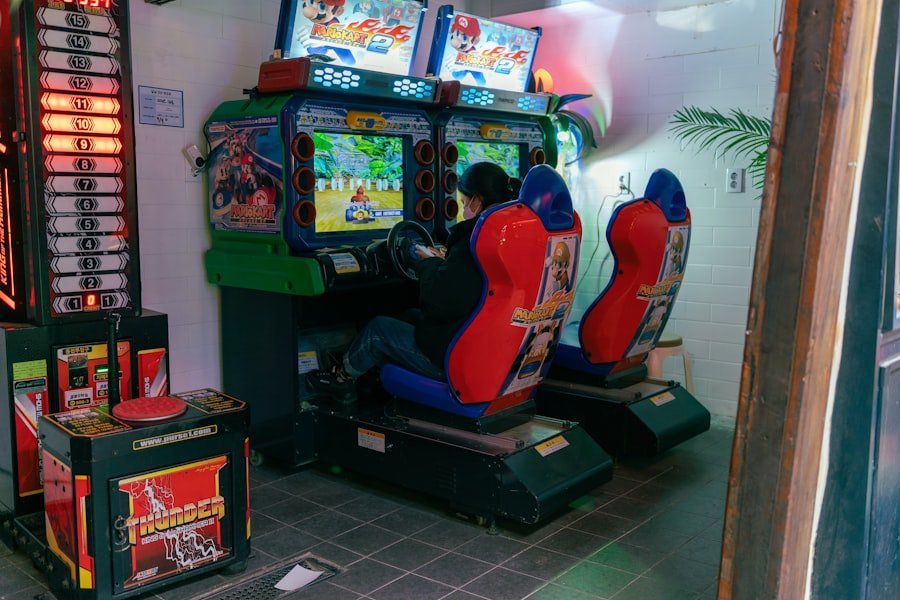Now Reading: DIY Guide: Building a Retro Arcade Cabinet at Home
-
01
DIY Guide: Building a Retro Arcade Cabinet at Home
DIY Guide: Building a Retro Arcade Cabinet at Home

As a child of the 80s and 90s, I have fond memories of spending countless hours in dimly lit arcades, surrounded by the sounds of beeping machines and the thrill of competition. The allure of retro arcade cabinets has always captivated me, and as I grew older, I found myself yearning to recreate that nostalgic experience in my own home. The idea of building my own arcade cabinet became a passion project, a way to blend my love for gaming with my desire to craft something unique.
In this article, I will take you through the journey of creating a retro arcade cabinet from scratch, sharing insights and tips that I’ve gathered along the way. The charm of retro arcade cabinets lies not only in their classic games but also in their iconic designs. Each cabinet tells a story, from the vibrant artwork that adorns its sides to the distinctive sounds that echo from its speakers.
Whether you’re a seasoned DIY enthusiast or a novice looking for a fun project, creating your own arcade cabinet can be an incredibly rewarding experience. Let’s dive into the planning and design phase, where the vision for my cabinet began to take shape.
Key Takeaways
- Retro arcade cabinets are a fun and nostalgic way to enjoy classic arcade games at home.
- Planning and designing your arcade cabinet is crucial for a successful build.
- Gathering the right materials and tools is essential for a smooth construction process.
- Building the cabinet frame is the foundation of your arcade cabinet and requires precision and attention to detail.
- Installing the monitor and controls is a key step in bringing your arcade cabinet to life.
Planning and Designing Your Arcade Cabinet
Choosing the Right Style
Ultimately, I decided on a full-sized upright cabinet, as it would provide an authentic arcade feel while allowing me to incorporate a larger screen and more controls. Once I settled on the style, I sketched out my design, paying close attention to the dimensions and layout.
Design and Ergonomics
I wanted to ensure that the controls were ergonomically placed for comfortable gameplay. I also considered the type of games I wanted to include, which influenced my choice of buttons and joystick configurations.
Visualizing the Final Product
This stage was crucial; it allowed me to visualize the final product and make adjustments before committing to any materials or construction.
Gathering Materials and Tools

With my design in hand, it was time to gather the necessary materials and tools for building my arcade cabinet. I made a comprehensive list of everything I would need, including plywood for the cabinet frame, a monitor, buttons, joysticks, and wiring components. I opted for high-quality materials to ensure durability and longevity, knowing that this cabinet would be a centerpiece in my home for years to come.
In addition to the materials, I also needed a variety of tools for the construction process. A circular saw was essential for cutting the plywood to size, while a drill would help me secure everything together. I also gathered sandpaper for smoothing edges and paint for finishing touches.
As I collected these items, I felt a sense of excitement building within me; each piece was a step closer to bringing my vision to life.
Building the Cabinet Frame
Once I had all my materials ready, it was time to start building the cabinet frame. I began by cutting the plywood according to my design specifications, carefully measuring each piece to ensure accuracy. As I worked with the saw, I felt a mix of anticipation and nervousness; this was where my vision would start taking physical form.
After cutting all the pieces, I laid them out on the floor to visualize how they would fit together. Assembling the frame was both challenging and rewarding. I used wood glue and screws to secure each joint, ensuring that everything was sturdy and well-aligned.
It was important to me that the cabinet could withstand years of enthusiastic gameplay without wobbling or falling apart. As I tightened the last screw and stood back to admire my work, I felt an overwhelming sense of accomplishment. The frame was solid, and it was beginning to look like an arcade cabinet.
Installing the Monitor and Controls
With the frame complete, it was time to install the monitor and controls—two critical components that would define the gaming experience. I carefully measured the space where the monitor would go, ensuring it was at eye level for comfortable viewing during gameplay. After securing the monitor in place with brackets, I took a moment to appreciate how much closer I was getting to completing my project.
Next came the installation of the controls—joysticks and buttons that would allow me to interact with the games. I opted for a layout that mirrored classic arcade machines, with two joysticks and several buttons for each player. As I drilled holes into the control panel for each component, I felt a surge of excitement; this was where the magic would happen.
Once everything was in place, I connected the wiring according to the instructions provided with my control kit, ensuring that each button corresponded correctly with its function.
Wiring and Connecting the Components

Wiring and connecting all the components was perhaps one of the most intricate parts of building my arcade cabinet. With so many wires running from the controls to the monitor and gaming system, organization was key. I took my time labeling each wire as I connected them, which helped prevent confusion later on.
It was essential for me to ensure that everything was properly connected; any mistakes could lead to frustrating troubleshooting down the line. As I worked through this process, I found myself immersed in a world of nostalgia. Each connection brought me closer to reliving those arcade moments from my childhood.
Once all components were wired together, I double-checked each connection before moving on to testing everything out. The anticipation built as I prepared to see if all my hard work would pay off.
Adding Artwork and Graphics
With all components connected and secured, it was time for one of my favorite parts: adding artwork and graphics to my arcade cabinet. This step allowed me to infuse my personality into the design while paying homage to classic arcade aesthetics. I spent hours browsing online for high-resolution images and designs that resonated with me—everything from retro game characters to vibrant patterns.
After selecting my artwork, I printed it out on adhesive vinyl sheets. Carefully applying each piece required patience and precision; any bubbles or misalignments could detract from the overall look. As I stepped back to admire my work after applying the graphics, I felt an overwhelming sense of pride wash over me.
The cabinet had transformed from a simple wooden structure into a vibrant piece of art that reflected my love for gaming.
Installing the Gaming System
The next step in my journey involved installing the gaming system itself—a crucial element that would bring my arcade cabinet to life. After researching various options, I decided on a Raspberry Pi setup loaded with emulators for classic games. This choice allowed me access to a vast library of retro titles while keeping costs manageable.
Setting up the Raspberry Pi required some technical know-how, but thankfully there were plenty of online resources available to guide me through the process. After installing the necessary software and configuring settings for optimal performance, it was time to connect it all back to my cabinet’s monitor and controls. As everything powered up successfully for the first time, a wave of excitement washed over me; this was it—the moment when all my hard work began to pay off.
Testing and Troubleshooting
With everything installed, it was time for testing—an exhilarating yet nerve-wracking phase of this project. As I powered on my arcade cabinet for its inaugural run, I felt a mix of anticipation and anxiety; would everything work as planned? To my delight, most functions operated smoothly right away!
However, there were some minor issues that needed addressing. I quickly discovered that one of the buttons wasn’t responding as expected during gameplay. Rather than letting frustration take over, I approached troubleshooting methodically.
By checking connections and reconfiguring settings within the software, I managed to resolve most issues fairly quickly. This process taught me valuable lessons about patience and problem-solving—skills that are essential not just in DIY projects but in life as well.
Adding Finishing Touches
As testing wrapped up successfully, it was time for those final finishing touches that would elevate my arcade cabinet from great to extraordinary. This included adding LED lighting around the edges for an eye-catching glow during gameplay sessions—a feature that truly captured that authentic arcade vibe. After installing LED strips along key areas of the cabinet’s frame, I programmed them to change colors based on different game themes.
Additionally, I took some time to create custom marquees featuring iconic game titles that would light up above the monitor when powered on. These small details made all the difference in enhancing both aesthetics and functionality; they transformed my cabinet into something truly special—a personal homage not just to gaming but also creativity itself.
Enjoying Your Homemade Retro Arcade Cabinet
Finally, after months of planning, building, and fine-tuning every detail, it was time for me to enjoy my homemade retro arcade cabinet! Inviting friends over for a gaming night felt like an incredible milestone; sharing this labor of love with others brought immense joy. As we gathered around playing classic titles like Pac-Man and Street Fighter II together again—laughter filling our living room—I realized just how fulfilling this journey had been.
Every moment spent working on this project had been worth it; not only did I create something tangible but also rekindled cherished memories while forging new ones with friends and family alike. My homemade retro arcade cabinet became more than just a gaming machine—it became a centerpiece of connection—a bridge between generations united by nostalgia and shared experiences in gaming culture. In conclusion, building a retro arcade cabinet is an adventure filled with creativity, technical challenges, and ultimately immense satisfaction when you see your vision come alive!
Whether you’re reliving childhood memories or creating new ones with loved ones around you—there’s no denying that this project is worth every effort put into it!
If you’re looking to build a retro arcade cabinet at home, you may also be interested in reading about the most difficult games ever in the article

















